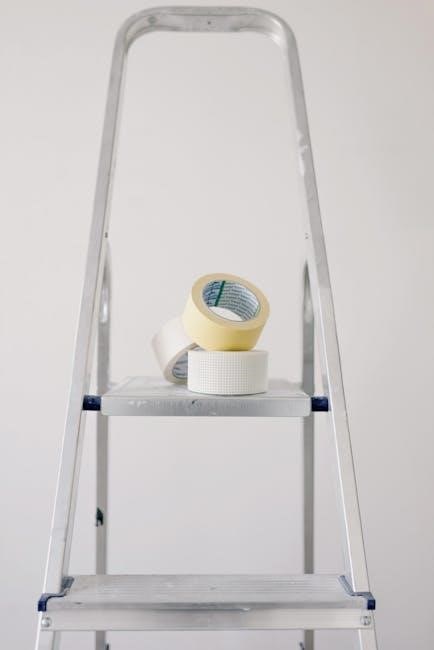Patellar tendonitis, or jumper’s knee, is an inflammatory condition affecting the patellar tendon, causing pain below the kneecap. Common in athletes, it often results from repetitive stress.
1.1 What is Patellar Tendonitis?
Patellar tendonitis, often called jumper’s knee, is an inflammatory condition affecting the patellar tendon, which connects the kneecap to the shinbone. It commonly arises from repetitive stress, such as jumping or running, leading to pain and swelling below the kneecap. This condition is prevalent among athletes involved in sports requiring frequent knee flexion and extension. While it can develop suddenly, it often results from chronic overuse, making it a significant concern for individuals with active lifestyles. Understanding its causes and symptoms is essential for effective management and recovery.
1.2 Symptoms and Diagnosis
Patellar tendonitis symptoms include pain and swelling below the kneecap, particularly during activities like jumping, running, or climbing stairs. The affected area may feel tender to the touch, and symptoms often worsen with continued stress on the knee. Diagnosis typically involves a physical examination to assess pain location and severity. Imaging tests like ultrasound or MRI may be used to confirm the condition and rule out other issues. Early recognition of symptoms is crucial for effective treatment and preventing further damage to the tendon. Proper diagnosis ensures targeted interventions, such as KT tape application, can be implemented effectively.
KT Tape is a popular kinesiology tape designed to provide support and relief for various injuries, including patellar tendonitis. Known for its durability and flexibility, it is widely used by athletes to reduce pain and inflammation. The tape works by lifting the skin to reduce pressure on sensitive areas and improving blood flow to promote healing. KT Tape can be applied using techniques like the U-Strip, which offers targeted support to the patellar tendon. Its versatility and non-restrictive nature make it a preferred choice for active individuals seeking to manage pain and maintain mobility during recovery.

Benefits of Using KT Tape for Patellar Tendonitis
KT Tape provides pain relief, reduces inflammation, and enhances knee stability without restricting movement. It offers a cost-effective, non-invasive solution for managing patellar tendonitis symptoms effectively.
2;1 Pain Relief and Reduced Inflammation
KT Tape helps alleviate pain and reduce inflammation in patellar tendonitis by lifting the skin to decrease pressure on the patellar tendon. This gentle lifting action enhances blood flow and lymphatic drainage, promoting healing. The tape reduces stress on the tendon, minimizing discomfort during activities. Its non-invasive nature makes it an ideal solution for athletes and individuals seeking immediate relief without medication. By stabilizing the knee, KT Tape also reduces friction, further lowering inflammation. This method is particularly effective during or after physical activity, offering both preventive and therapeutic benefits for those suffering from patellar tendonitis. Regular use can significantly enhance comfort and mobility.
2.2 Enhanced Knee Support and Stability
KT Tape provides exceptional knee support and stability for individuals with patellar tendonitis. By strategically placing the tape around the patella and quadriceps, it helps align the knee cap properly, reducing abnormal tracking that can exacerbate tendon irritation. The elastic properties of KT Tape offer dynamic support, allowing for a full range of motion while minimizing stress on the patellar tendon. This enhanced stability is particularly beneficial during physical activities, helping to prevent further injury and promote healing. The tape acts as an external brace, offering both structural support and proprioceptive feedback, which can improve joint function and reduce the risk of reinjury. Regular use can enhance athletic performance and daily mobility by maintaining proper knee mechanics.
2.3 Cost-Effective and Non-Invasive Solution
KT Tape offers a cost-effective and non-invasive solution for managing patellar tendonitis. Unlike expensive braces or lengthy physical therapy sessions, KT Tape provides immediate support at a fraction of the cost. Its reusable design allows for multiple applications, further reducing expenses. Additionally, it avoids the need for invasive procedures or medications, making it a safe and accessible option for many individuals. The simplicity of its application also eliminates the need for professional assistance, empowering users to take control of their recovery. This makes KT Tape an appealing choice for both athletes and non-athletes seeking an affordable solution.

How to Apply KT Tape for Patellar Tendonitis
Applying KT Tape involves specific techniques to support the patellar tendon. Start by cleaning and drying the skin. Place the first strip below the kneecap, aligning with the tendon, and apply without stretching. Add a second strip above the kneecap for additional support. Smooth the tape firmly to ensure adhesion. Avoid stretching the tape too tightly to prevent discomfort. This method provides stability and pain relief, promoting healing and comfort during activity.
3.1 Step-by-Step Application Guide
Start by cleaning and drying the skin to ensure proper adhesion. Apply a base strip of KT Tape vertically along the patellar tendon, avoiding wrinkles. Place one strip above the kneecap and another below, aligning with the tendon’s direction. Gently stretch the tape as you apply it, ensuring it conforms to the contour of the knee. Avoid stretching the tape over the kneecap itself. Smooth each strip firmly to secure it. Trim any excess tape at the edges. This method provides targeted support and stability, reducing strain on the patellar tendon while allowing for a full range of motion.
3.2 The U-Strip Technique
The U-Strip Technique involves creating a supportive “U” shape around the patella (kneecap). Begin by cutting two KT Tape strips to the required length. Place one strip horizontally below the patella, aligning it with the patellar tendon, and another strip above the patella, ensuring both strips meet at the sides of the knee. Gently press the tape to secure it, avoiding stretching over the kneecap to prevent irritation. This method provides additional stability and support, reducing stress on the tendon while maintaining flexibility. It’s especially effective for active individuals seeking to prevent further strain during physical activities.
3.3 Common Mistakes to Avoid
When applying KT Tape for patellar tendonitis, several common mistakes can reduce its effectiveness. Overstretching the tape during application is a frequent error, as it can cause discomfort or restrict movement. Another mistake is placing the tape directly over the patella, which may lead to irritation. Additionally, failing to prepare the skin properly—such as not trimming hair or cleaning the area—can weaken adhesion and cause skin reactions. Applying the tape too tightly or too loosely can also negate its supportive benefits. Lastly, reusing tape or leaving it on for extended periods can compromise its adhesive properties and hygiene.

Different Techniques and Variations
KT Tape offers various application techniques, such as Y-strips for support or I-strips to reduce tension, allowing customization for individual needs and preferences.
4.1 Tendon Corrective Strip and Muscle Facilitative Strip
The Tendon Corrective Strip is applied directly over the patellar tendon to provide targeted support and correct tracking issues, reducing pain and inflammation. The Muscle Facilitative Strip is used to activate the surrounding quadriceps and calf muscles, improving circulation and reducing muscle spasms. Together, these techniques address both the tendon and muscle imbalances, promoting optimal recovery and function. Proper application ensures the strips work synergistically, offering comprehensive support and pain management for patellar tendonitis sufferers.
4.2 Combining KT Tape with Other Treatments
KT Tape can be effectively combined with other treatments for patellar tendonitis, such as physical therapy, icing, and anti-inflammatory medications. This multimodal approach enhances pain relief and accelerates recovery. For instance, applying KT Tape alongside strengthening exercises improves knee stability and function. It can also complement bracing or orthotic use, offering additional support without restricting movement. Combining KT Tape with low-level laser therapy or ultrasound further enhances tissue repair. This integrated strategy allows individuals to tailor their treatment plan, addressing both acute symptoms and long-term recovery goals effectively.

Scientific Evidence and Studies
Research shows KT Tape provides short-term pain relief and functional improvement for patellar tendonitis, though evidence remains mixed on its long-term benefits compared to other treatments.
5.1 Research on KT Tape’s Effectiveness
Studies examining KT Tape’s effectiveness for patellar tendonitis show mixed results. Some research indicates that KT Tape can reduce pain and improve functional outcomes in the short term. However, other studies suggest that its benefits may be comparable to placebo effects or traditional taping methods. A 2018 systematic review found that while KT Tape provided immediate pain relief, its long-term efficacy remained uncertain. Another study highlighted improvements in quadriceps strength and jumping performance among athletes using KT Tape. Overall, the evidence supports KT Tape as a useful adjunct therapy, though more robust research is needed to confirm its sustained benefits.
5.2 Comparative Studies with Other Orthoses
Comparative studies have evaluated KT Tape against other orthoses like patellar braces and sleeves. Research indicates that KT Tape is as effective as orthopedic braces in reducing pain and improving function for patellar tendonitis. A 2020 study in the Journal of Athletic Training found similar outcomes between KT Tape and patellar braces in improving jump performance. However, braces provided greater structural support during high-impact activities. Another study in Physical Therapy in Sport noted that KT Tape offered better comfort and flexibility compared to rigid orthoses, making it a preferred choice for athletes seeking minimal restriction. These findings suggest KT Tape is a viable alternative for short-term use.

Effectiveness of KT Tape for Patellar Tendonitis
KT Tape effectively reduces pain and provides support for patellar tendonitis, enhancing mobility without restricting movement, making it a popular choice for athletes and active individuals.
6.1 Short-Term Pain Relief and Functional Improvement
KT Tape provides immediate short-term pain relief by reducing stress on the patellar tendon, allowing for improved functional movement. It helps alleviate discomfort during activities like running or jumping. The tape’s lifting effect enhances blood flow, reducing inflammation and promoting healing. Many users report increased comfort and mobility within hours of application. Studies suggest KT Tape can improve joint range of motion and reduce pain intensity, making it an effective short-term solution for managing patellar tendonitis symptoms.
6.2 Long-Term Use and Recovery Support
KT Tape can be worn continuously for several days, offering sustained support during the recovery process. Long-term use helps maintain tendon stability, reducing the risk of reinjury. It promotes proper movement patterns, which is crucial for healing. While not a cure, KT Tape complements therapies like physical rehabilitation and rest. Consistent use can enhance the body’s natural repair mechanisms, supporting long-term recovery. However, it’s essential to combine taping with a comprehensive treatment plan for optimal results.

Comparing KT Tape to Other Treatments
KT Tape offers a flexible, non-restrictive alternative to braces and supports, providing pain relief without limiting mobility. It is cost-effective and reusable, making it a practical choice for long-term recovery support compared to other treatments.
7.1 KT Tape vs. Patellar Straps and Braces
KT Tape provides a flexible, non-restrictive alternative to patellar straps and braces, offering support without limiting mobility. Unlike bulky braces, KT Tape is lightweight and cost-effective, making it ideal for athletes seeking a low-profile solution. While patellar straps apply direct pressure to reduce pain, KT Tape promotes blood flow and reduces inflammation through its elastic properties. Braces may offer more rigid support for severe cases, but KT Tape excels in allowing natural movement, making it a preferred choice for active individuals. The choice between KT Tape and braces often depends on the severity of symptoms and the need for mobility.
7.2 KT Tape vs. Physical Therapy and Rehabilitation
KT Tape complements physical therapy by providing additional support and pain relief during rehabilitation. While physical therapy focuses on strengthening muscles and improving mobility, KT Tape helps reduce strain on the patellar tendon, allowing for more effective exercises. Unlike physical therapy, KT Tape is a passive treatment that can be applied at home. However, it is not a replacement for structured rehabilitation programs. Combining KT Tape with physical therapy enhances recovery by addressing both pain and underlying muscle imbalances. This dual approach often leads to faster and more sustainable results for patellar tendonitis sufferers.
Special Considerations and Precautions
Proper application, skin sensitivity, and medical clearance are key. KT Tape is not a cure but supports recovery. Use with caution for severe injuries or allergies.
8.1 When to Use KT Tape
KT Tape is ideal for mild to moderate patellar tendonitis, providing support during physical activity or rehabilitation. Use it for acute pain, chronic inflammation, or to prevent flare-ups. Apply before sports, especially high-impact activities like running or cycling. It’s also beneficial for individuals transitioning back to exercise post-injury. However, avoid using KT Tape on open wounds or severe tendon ruptures. Consult a healthcare professional before applying if you have severe pain or instability. Use it alongside other treatments like physical therapy for optimal results, but not as a standalone solution for advanced cases.
8.2 Contraindications and Side Effects
KT Tape is generally safe but may not be suitable for everyone. Avoid using it on open wounds, skin irritations, or allergies to adhesives. Individuals with sensitive skin may experience redness or itching after removal. Diabetics or those with circulation issues should use caution. KT Tape is not recommended for severe tendon ruptures or complete ligament tears. It should not replace medical treatment for acute injuries. If pain worsens or swelling persists, discontinue use and consult a healthcare professional. Use with caution in cases of eczema or dermatitis near the application area.
Case Studies and Athlete Experiences
Real-life examples highlight KT Tape’s effectiveness in reducing patellar tendonitis pain and improving athletic performance. Athletes report enhanced comfort and quicker recovery during high-impact activities.
9.1 Real-Life Examples of KT Tape Success
Professional athletes and runners have shared positive experiences with KT Tape for patellar tendonitis. Many report significant pain reduction during high-impact activities like marathons or basketball games. One marathon runner noted that KT Tape provided the necessary support to finish a race without discomfort. Similarly, a basketball player highlighted how the tape helped reduce inflammation and improve stability. These real-life examples demonstrate KT Tape’s effectiveness in enabling athletes to perform at their best while managing tendonitis. The testimonials emphasize its role in enhancing recovery and maintaining activity levels without resorting to invasive treatments.
9.2 Athlete Testimonials and Feedback
Athletes across various sports have praised KT Tape for its effectiveness in managing patellar tendonitis. A professional soccer player reported that KT Tape provided immediate pain relief, allowing him to train without discomfort. A cross-country runner shared that the tape offered consistent support during long races, preventing flare-ups. Many athletes appreciate its lightweight design and durability, even during intense sweat sessions. Feedback highlights how KT Tape enables them to maintain performance levels while recovering. These testimonials underscore its practicality and effectiveness as a non-invasive solution for active individuals dealing with patellar tendonitis.

Tips for Optimal Results
Proper application on clean, dry skin, using correct tension, and applying before activity ensures optimal results and prevents further irritation, promoting support and healing.
10.1 Preparing the Skin Before Application
Proper skin preparation is crucial for effective KT Tape application. Begin by washing the area with soap and water to remove dirt, oils, and lotions, which can reduce adhesion; Dry the skin thoroughly, as moisture prevents the tape from sticking properly. Trim excess hair to ensure better contact and avoid irritation. Exfoliate gently to remove dead skin cells, enhancing the tape’s grip. Avoid applying lotions or creams post-cleansing, as they can interfere with adhesion. Ensure the skin is free of cuts or abrasions before taping to prevent further discomfort. Clean, dry, and prepared skin ensures optimal KT Tape performance and durability.
10.2 Maintaining and Reapplying KT Tape
To maintain KT Tape effectiveness, clean the area gently with soap and water while the tape is still on. Avoid using oils or harsh chemicals, as they weaken adhesion. If fraying occurs, trim loose edges with scissors. Reapply tape every 3-5 days or sooner if it loosens. After swimming or excessive sweating, reapply to ensure proper grip. Remove old tape slowly and gently to avoid skin irritation. Reapply on clean, dry skin for optimal results. Proper maintenance extends the tape’s life and enhances its supportive benefits for patellar tendonitis relief.
KT Tape offers a practical, non-invasive solution for managing patellar tendonitis, providing pain relief and support. Its effectiveness is supported by both clinical evidence and user testimonials, making it a valuable tool for recovery and activity continuation.
11.1 Summary of KT Tape Benefits
KT Tape is a highly effective, non-invasive solution for patellar tendonitis, offering immediate pain relief, enhanced knee stability, and reduced inflammation. Its breathable, waterproof design provides long-lasting support without restricting movement. Easy to apply and cost-effective, KT Tape is a practical alternative to braces or surgery. It promotes blood flow, accelerates recovery, and allows individuals to maintain an active lifestyle. Suitable for athletes, runners, and individuals with chronic tendonitis, KT Tape is a versatile tool for managing symptoms and supporting long-term recovery; Its simplicity and efficacy make it a popular choice among healthcare professionals and patients alike.
11.2 Recommendations for Patellar Tendonitis Sufferers
For individuals suffering from patellar tendonitis, combining KT Tape with physical therapy and strengthening exercises is highly recommended. Proper application techniques ensure maximum support and pain relief. It’s essential to avoid overstretching the tape and to remove it gently to prevent skin irritation. Regular icing and rest can complement the tape’s benefits. Consulting a healthcare professional for severe cases is advised. Consistency in reapplying the tape and maintaining proper knee alignment during activities can enhance recovery. By following these guidelines, sufferers can optimize their relief and support, fostering a faster return to normal activities and sports.

Additional Resources and Guides
Downloadable PDF guides and video tutorials provide step-by-step instructions for KT Tape application, ensuring proper technique and maximizing benefits for patellar tendonitis relief.
12.1 Downloadable PDF Guides
Downloadable PDF guides offer comprehensive instructions for applying KT Tape to alleviate patellar tendonitis. These guides include detailed diagrams, step-by-step instructions, and expert tips for optimal taping techniques. Many official KT Tape websites and sports medicine resources provide free PDF downloads, ensuring easy access to visual aids and written instructions. These guides are perfect for athletes, physical therapists, and individuals seeking self-treatment solutions. They cover various taping methods, addressing different severity levels of patellar tendonitis. Accessible and user-friendly, these PDF resources empower users to apply KT Tape confidently and effectively, enhancing recovery and pain management outcomes.
12.2 Video Tutorials and Application Instructions
Video tutorials provide a dynamic and visual guide for applying KT Tape to treat patellar tendonitis. These tutorials, available on platforms like YouTube, official KT Tape websites, and sports medicine channels, demonstrate step-by-step techniques and proper taping methods. Physical therapists and experienced athletes often share tips to ensure correct application and maximize benefits. Videos cater to different skill levels, from beginners to advanced users, offering modifications for various pain levels or activity types. They also highlight common mistakes to avoid, ensuring users achieve optimal support and pain relief. These resources are free, accessible, and ideal for visual learners seeking to master KT Tape application effectively.

Patellar Tendonitis in Specific Populations
KT Tape is beneficial for athletes, runners, and individuals with chronic tendonitis, offering targeted support and pain relief. It caters to adolescents and young athletes, aiding recovery and enhancing performance.
13.1 Athletes and Runners
KT Tape is highly effective for athletes and runners suffering from patellar tendonitis. It provides targeted support to the patellar tendon, reducing pain and inflammation during high-impact activities. The tape helps alleviate stress on the knee, allowing athletes to maintain performance levels. Its breathable, waterproof design makes it ideal for endurance sports. Many runners and athletes use KT Tape as a preventative measure to avoid flare-ups. It enhances stability and promotes proper tracking of the patella, reducing the risk of further injury. This makes it a popular choice among active individuals seeking non-invasive, cost-effective solutions to manage patellar tendonitis.
13.2 Adolescent and Young Athletes
KT Tape is particularly beneficial for adolescent and young athletes with patellar tendonitis, as it supports the knee during repetitive jumping and running. The tape helps reduce pain and inflammation, enabling young athletes to continue training without exacerbating the injury. Its non-restrictive design allows for a full range of motion, which is crucial during growth spurts. Many young athletes use KT Tape as a precautionary measure to prevent overuse injuries. While it aids in recovery, it’s important to combine it with proper rest and strengthening exercises. Early intervention with KT Tape can help young athletes avoid long-term tendon damage.
13.3 Individuals with Chronic Tendonitis
KT Tape can be a valuable tool for individuals with chronic patellar tendonitis, providing ongoing support and pain relief. For those with persistent inflammation, the tape helps reduce stress on the tendon, promoting comfort during daily activities and exercise. It’s particularly useful for individuals who require long-term management of their condition. However, it’s essential to use KT Tape in conjunction with other therapies, such as physical therapy and rest, to address the root cause of the chronic issue. While KT Tape offers symptom relief, it should not replace professional medical advice or comprehensive treatment plans for chronic tendonitis.